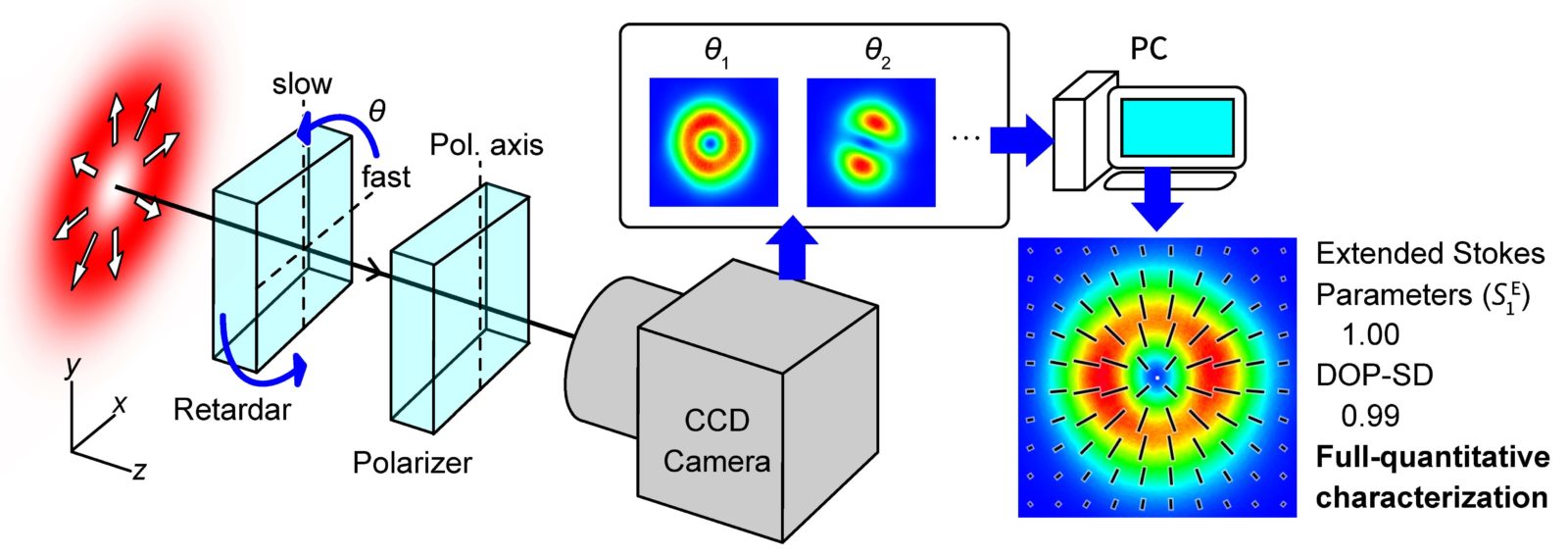High-Speed and Fully-Quantitative Evaluation of the Polarization Distribution of a Radially Polarized Laser Beam
Research Press Release | December 25, 2015

| Press Release | ||
|---|---|---|
| Key Points |
・New development of a fully-quantitative evaluation method using the concepts of extended Stokes parameters and the degree of polarization defined for the spatial distribution (DOP-SP). ・Use of the rotating-retarder method to capture the polarization distribution, and implementation of completely automatic measurement in a short time. ・Ability to detect unnecessary laser beam contamination with a precision of several percent. |
|
|
Outline |
We have developed a new, fully-quantitative evaluation method for a laser beam whose polarization distribution1 is radial, which is known as a “radially polarized laser beam.” By using the concepts of extended Stokes parameters and the degree of polarization defined for the spatial distribution (DOP-SP)2, which have been uniquely presented by this research group, we implemented fully-quantitative evaluation, which had not been conducted in prior research. By using the rotating-retarder method3, which is often adopted in polarization analysis equipment (ellipsometry), for the measurement system we captured the polarization distribution of a radially polarized laser beam in a completely automatic way. Also, the development of special-purpose software made it possible to perform all the steps, from measurement of the polarization distribution of the radially polarized laser beam through the fully-quantitative evaluation calculation, in a short time (total of about one minute). Furthermore, this method is able to detect the contamination of an unnecessary laser beam that is not a radially polarized laser beam, with an accuracy of several percent. For the first time in the world, this research has experimentally certified the ability to quantitatively and directly express the quality of a radially polarized laser beam and of the equipment that generates it. This is expected to contribute to the implementation of laser applications such as more refined and more advanced material processing, and faster and larger-capacity optical multiplexing communication. The results of this research have been obtained with the support of the Japan Science and Technology Agency (JST), Strategic Basic Research Programs CREST Research Area, “Enhancing Application of Innovative Optical Science and Technologies by making Ultimate Use of Advanced Light Sources” (Research Supervisor: Tadashi Ito, Professor, Osaka University), research theme: “Material control by topological light-waves with total angular momentum” (Research Representative: Takashige Omatsu, Professor, Chiba University), and by a Grant-In-Aid for Scientific Research from the Japan Society for the Promotion of Science (JSPS). |
|
|
Terms |
1 Polarization Distribution A laser beam is an electromagnetic wave. The “polarization,” or “polarization state,” shows the direction in which the electromagnetic wave is vibrating as a wave (in particular, it shows the direction of vibration of the electric wave, which is part of the electromagnetic wave). The “polarization distribution” shows the direction of the polarization at various locations within the cross-section of the laser beam. 2 Extended Stokes Parameters and Degree of Polarization Defined for the Spatial Distribution (DOP-SP) The Stokes parameters and degree of polarization are quantitative indices that have traditionally been used in optics to show the polarization state. This research group has newly presented the “extended Stokes parameters” and “DOP-SD”, which extend these concepts so that they can be applied to a radially polarized laser beam (Fig. 1a). The extended Stokes parameters are generally a set of three parameters (S1E, S2E, S3E), and the extended degree of polarization is shown by a single parameter (PE). However, since an ideal radially polarized laser beam is expressed by S1E = 1, S2E = 0, S3E = 0, and PE = 1, the two most important parameters are considered to be the (first) extended Stokes parameter S1E and the DOP-SD PE. 3 Rotating-Retarder Method The rotating-retarder method is a method used to capture the polarization state of a laser beam. As shown in Fig. 3, equipment, such as a CCD camera, that can measure laser intensity is placed behind a pair consisting of a retarder (an element that modifies the polarization state) and a polarizer (an element that only allows the polarization state for a certain direction to pass through). Then, the rotation angle of the retarder is changed (while the polarizer is fixed), data that consists of multiple pairs of rotation angles and laser intensities is captured, and the polarization state is evaluated by computer processing. |
|
| Inquiries |
Ryuji Morita, Professor, Laboratory of Nonlinear Optics and Laser Physics, Division of Applied Physics, Faculty of Engeneering, Hokkaido University Phone: +81-11-706-6626 FAX: +81-11-706-6626 E-mail: morita[at]eng.hokudai.ac.jp |
|
|
Japanese Link |
径偏光レーザービームの偏光分布を 高速で完全定量的に評価する手法を開発 (12.11.2015) | |
| Publications | Full Quantitative Analysis of Arbitrary Cylindrically Polarized Pulses by Using Extended Stokes Parameters, Scientific Reports (12.10.2015) | |
